 When it comes to graffiti, aside from the cost to clean and repair (which can be expensive), graffiti’s most insidious and pervasive cost is to a community’s sense of security.
When it comes to graffiti, aside from the cost to clean and repair (which can be expensive), graffiti’s most insidious and pervasive cost is to a community’s sense of security.The effect of graffiti on a community is often likened to the metaphor of a “broken window”. This theory was first proposed by James Q. Wilson and George L. Kelling in a March 1982 article called “Broken Windows” in The Atlantic Monthly, and can be synopsized through the following excerpt.
Viewed through this frame, graffiti similarily acts as an indicator of communal neglect and lack of care. One graffiti tag becomes an open call for other graffiti writers to add in their voice…in support or in challenge. Before long, if left unchecked, the tagged surface becomes a message board which all taggers feel free and obliged to use to make their voices and presence heard."Consider a building with a few broken windows. If the windows are not repaired, the tendency is for vandals to break a few more windows. Eventually, they may even break into the building, and if it's unoccupied, perhaps become squatters or light fires inside.
Or consider a sidewalk. Some litter accumulates. Soon, more litter accumulates. Eventually, people even start leaving bags of trash from take-out restaurants there or breaking into cars."
The “Broken Widow” theory was eventually put to the test by the City of New York in the 1980. New York had been facing a steady and dramatic increase and escalation in criminal activities.
The NYC Subway was totally overrun with graffiti and toll dodging was a common occurrence. As a test of the Broken Window theory in 1985 the New York City Transit Authority implemented a zero tolerance program towards graffiti and toll-jumping. This included ensuring that all graffitied subway cars were checked and cleaned after each run and not put back into service until they were free of all graffiti.
Though the effect of these actions are often questioned and difficult to definitively inter-relate, the change in atmosphere and perception of security in New York City between the early 1980s and the present day is dramatic and radical. The NYC Subway Broken Window test bed led to further sweeping changes by Mayor Rudy Giuliani during the 1990s which resulted in the revitalization of the commercial downtown core of NYC and the gentrification of New York City’s boroughs.






No comments:
Post a Comment